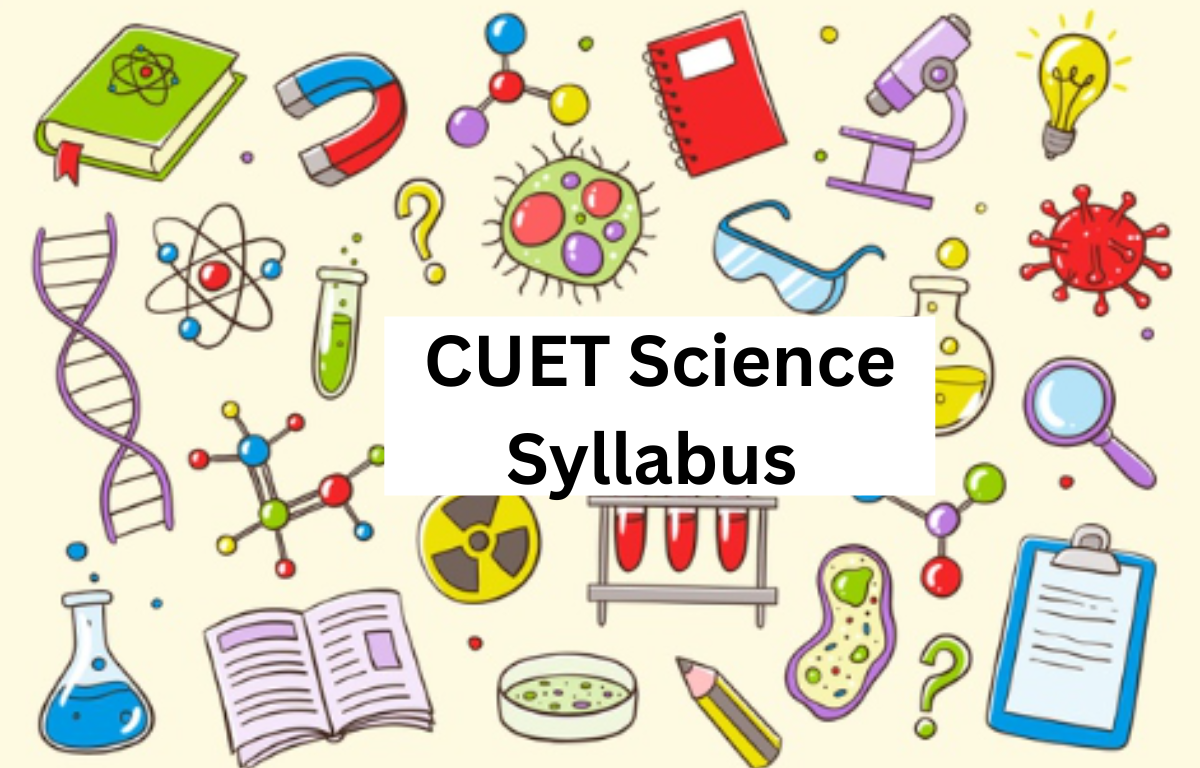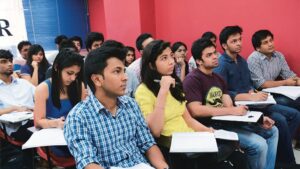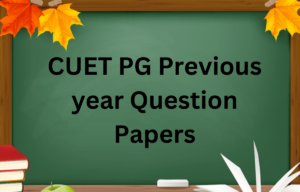CUET Science Syllabus 2026: The Common University Entrance Test or the CUET Exam, is a national-level entrance examination conducted annually by the NTA at various examination centers as a process of admission into various bachelor-level courses. All the students who have completed their 12th class or equivalent level of education from a recognized institution in the science stream or want to continue their education with the same, can also apply to appear for the CUET UG 2026 exam. To help such students, the CUET Science Syllabus 2026 has been detailed and shared in the article below. Scroll down in the article and check the complete syllabus for all the major subjects of the science stream, including Physics, Chemistry, Mathematics, and Biology.
CUET Syllabus 2026 for Science Students
The CUET (Common University Entrance Test) science stream syllabus covers subjects like Physics, Chemistry, Mathematics, and Biology. In Physics, students learn about basic concepts like motion, energy, and electricity. Chemistry includes topics like elements, compounds, and chemical reactions. Mathematics focuses on numbers, algebra, geometry, and calculus. Biology covers topics related to living organisms, such as cells, plants, animals, and human biology.
By studying this syllabus, students can better prepare for questions, improve their understanding, and increase their chances of success in the entrance test. The CUET Syllabus is designed to test a student’s understanding of key concepts and problem-solving skills. It is important to study all these topics carefully, as they form the foundation for further studies in science and engineering.
Subject-Wise CUET Science Syllabus 2026
The CUET Syllabus for the Common University Entrance Test has been released online by the NTA at its official website so that all the aspirants who are preparing for the exam can check and start preparing for the exam. Below, we have added the CUET Syllabus 2026 for the Science Stream has been added for the Physics, Chemistry, Biology, and Mathematics subject. All the aspirants who are from the science stream and are looking forward for appearing for the Science stream courses can visit down in the article to check the CUET Science Syllabus 2026:
CUET UG Physics Syllabus
The CUET Physics Syllabus is based on topics such as motion, force, energy, heat, waves, light, electricity, and magnetism from the 11th and 12th classes. Some questions also come from modern physics. To prepare well, focus on basic concepts, formulas, and problem-solving. Reading NCERT books and practicing past papers will be very helpful.
- Electrostatics
- Current Electricity
- Magnetic Effects of Current and Magnetism
- Electromagnetic Induction and Alternating Currents
- Electromagnetic Waves
- Optics
- Dual Nature of Matter and Radiation
- Atoms and Nuclei
- Electronic Devices
- Communication Systems
CUET UG Chemistry Syllabus
The CUET Chemistry Syllabus covers Physical, Organic, and Inorganic Chemistry topics from Class 11 and 12 NCERT books. It includes atomic structure, chemical bonding, states of matter, equilibrium, thermodynamics, hydrocarbons, biomolecules, and coordination compounds. Students should focus on concepts, formulas, and reactions. Practicing previous year questions and mock tests will help in understanding the exam pattern and improving accuracy.
- Solid
- State Solutions
- Electrochemistry
- Chemical Kinetics
- Surface Chemistry
- General Principles and Processes of Isolation of Elements
- p-Block Elements
- d and f Block Elements
- Coordination Compounds
- Haloalkanes and Haloarenes
- Alcohols, Phenols, and Ethers
- Aldehydes, Ketones, and Carboxylic Acid
- Organic Compounds Containing Nitrogen
- Biomolecules
- Polymers
- Chemistry in Everyday Life
CUET UG Biology Syllabus 2026
The CUET Biology Syllabus covers topics from Class 11 and 12 NCERT books. It includes subjects like cell structure, human physiology, genetics, evolution, plant physiology, ecology, and biotechnology. Students should focus on key concepts, diagrams, and important definitions. Multiple-choice questions (MCQs) test the understanding and application of concepts. Regular revision and practicing past questions can help in scoring well on the exam.
- Reproduction
- Genetics and Evolution
- Biology and Human Welfare
- Biotechnology and Its Applications
- Ecology and Environment
CUET Maths Syllabus
The CUET Maths Syllabus includes topics from Class 11 and 12. It covers Algebra, Calculus, Trigonometry, Probability, Statistics, Coordinate Geometry, and Vectors. Key areas include functions, differentiation, integration, matrices, and determinants. Students should focus on formulas, problem-solving, and application-based questions. Regular practice and understanding of concepts will help in scoring well in the exam.
Section A
- Algebra
- Calculus
- Integration and its Application
- Differential Equation
- Probability Distributions
- Linear Programming
Section B1
- Relations And Functions
- Algebra
- Calculus
- Vectors and Three-Dimensional Geometry
- Linear Programming
- Probability
Section B2
- Numbers, Quantification, and Numerical Applications
- Algebra
- Calculus
- Probability Distributions
- Index Numbers And Time-Based Data
- Financial Mathematics
- Linear Programming
CUET English and Other Language Syllabus
The CUET UG language syllabus for science stream students focuses on testing language skills in English or regional languages. It includes reading comprehension, grammar, vocabulary, and writing skills. Students are tested on their ability to understand passages, correct grammatical errors, and use words properly. The exam may also have questions on synonyms, antonyms, and sentence structure. To understand it more clearly, students must go through the CUET English Syllabus carefully.
- Reading Comprehension: It will include three types of passages of a maximum of 300-350 words:
- Factual
- Narrative
- Literary
- Verbal Ability
- Rearranging the parts
- Choosing the correct word
- Synonyms and Antonyms
- Vocabulary
CUET General Test Syllabus
The CUET General Test Syllabus for science stream students covers a range of topics. It includes general knowledge, current affairs, logical reasoning, and numerical ability. Students are tested on their understanding of everyday events, basic math skills, and their ability to think logically. The test may also include questions on topics like history, geography, and politics. The aim is to check how well students can think critically and solve problems, which are important skills for university studies.
- General Knowledge
- Current Affairs
- General Mental Ability
- Numerical ability
- Reasoning (simple application of basic mathematical concepts, quantitative arithmetic/ algebra geometry/ mensuration/ statistics)
- Logical and analytical reasoning
CUET UG Courses for Science Students
The CUET UG (Common University Entrance Test for Undergraduate) offers various courses for science students in multiple universities across India. These courses help students build careers in fields like engineering, medicine, research, and technology. After passing CUET UG, science students can choose from the following courses. These courses provide excellent career opportunities in scientific and technical fields.
- B.Sc. (Bachelor of Science) – Physics, Chemistry, Mathematics, Biology, Biotechnology, Environmental Science, Computer Science, etc.
- B.Tech. (Bachelor of Technology) – Various engineering disciplines like Computer Science, Electrical, Mechanical, Civil, etc.
- B.Pharm. (Bachelor of Pharmacy) – For a career in the pharmaceutical industry.
- B.Sc. (Hons.) – Specialized science subjects like Microbiology, Zoology, Botany, etc.
- Integrated M.Sc. – Five-year dual degree courses in scientific research.
CUET Exam Pattern 2026 for Science Students
The CUET UG exam is a key test for science stream students who want to get into good colleges. It includes multiple-choice questions from subjects like Physics, Chemistry, Biology, and Maths. Students can pick the subjects they studied in school. The exam is taken online and checks how well they know these topics. For every correct answer, they get marks, but marks are reduced for wrong answers. The final score helps decide which college they can get into. This exam is very important as it plays a big part in shaping their higher education and career path.
| CUET Subject Wise Exam Pattern for Science Students | |
| Subject Name | |
| Chemistry |
50 questions (40 questions to be attempted)Duration: 60 Minutes
|
| Biology |
50 questions (40 questions to be attempted)
Duration: 45 Minutes |
| Mathematics |
Section A- 15 questions (All compulsory)
Section B1- 35 questions (25 to be attempted) Section B2- 35 questions (25 to be attempted) Duration: 60 Minutes |
| Physics |
50 questions (40 questions to be attempted)
Duration: 60 Minutes |
| General Test |
60 questions (50 questions to be attempted)
Duration: 60 Minutes |
| Language |
50 questions (40 questions to be attempted)
Duration: 45 Minutes |
| Physical education |
50 questions (40 questions to be attempted)
Duration: 45 Minutes |
| Computer Science/ Informatics Practices |
Section A- 15 questions (All compulsory)
Section B1- 35 questions (25 to be attempted) Section B2- 35 questions (25 to be attempted) Duration: 60 Minutes |
CUET Science Syllabus 2026: Subject-Wise Important Topics
The table below shares the list of important topics that students need to study from the CUET Science Syllabus 2026. Check the subject-wise important topics list here:
| CUET Science Syllabus 2026: Subject-Wise Important Topics | |
| Subjects | Important Topics |
| CUET Physics Important Topics |
Electrostatics, Current Electricity, Magnetic Effects of Current and Magnetism, Electromagnetic Waves, Electronic Devices
|
| CUET Chemistry Important Topics |
Aldehyde, Ketone, and Carboxylic Acid, Amine, P-block, Surface Chemistry, Chemical Kinetics
|
| CUET Maths Important Topics |
Integration and its Applications, Calculus, Relations and Functions, Vectors, Integrals
|
| CUET Biology Important Topics |
Reproduction, Ecology and Environment, Genetics and Evolution, Biotechnology and Its Application
|
| CUET 2026 Computer Science Important Topics |
Networking, SQL, Bubble sorting
|



 Best CUET Coaching in Delhi - Factors De...
Best CUET Coaching in Delhi - Factors De...
 Best CUET Coaching in Noida - Get Top 5 ...
Best CUET Coaching in Noida - Get Top 5 ...
 CUET PG Previous Year Question Papers wi...
CUET PG Previous Year Question Papers wi...







